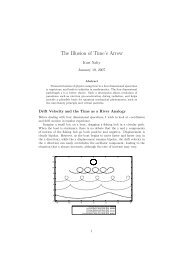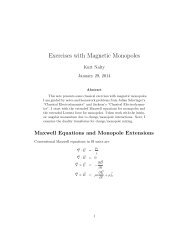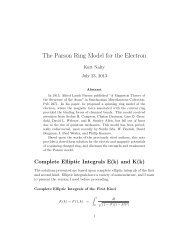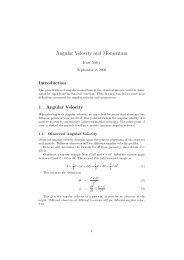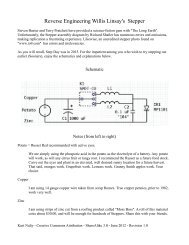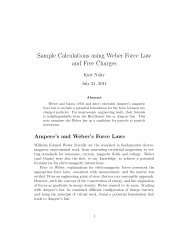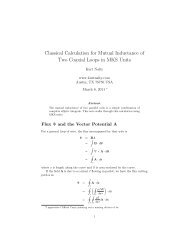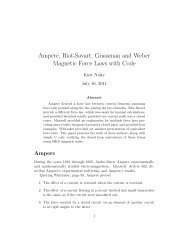Homopolar Generator Design Exercises - Kurt Nalty
Homopolar Generator Design Exercises - Kurt Nalty
Homopolar Generator Design Exercises - Kurt Nalty
You also want an ePaper? Increase the reach of your titles
YUMPU automatically turns print PDFs into web optimized ePapers that Google loves.
Unique Information from Finite Element SolutionSo, what information do we get from the finite element model that we didn’talready know from the pencil and paper calculations?As we look at the heatmap, we see that the rotor has a real voltagegradient (about 11%) along the outer surface. Current collection brushesshould be placed single file in the center plane of the rotor to reduce currentsin adjacent brushes in the z direction. Likewise, the low B in the center planeof the rotor reduces J ⃗ × B ⃗ forces on the current carrying brushes as well.We also notice at the inside radius of the stator near the rotor, that wehave a significant field concentration, and flux leakage into the shaft. Weshould radius this corner, increasing the local air gap, to reduce these fieldswhich may introduce currents into seals or bearing in this area. Otherwise,just make sure we don’t place bearings or seals in this location.The current collected on the outer rim needs to be evenly split, andtransported down the interior of the stator (becoming a compensating turn)to avoid high axial forces on the thrust bearing due to asymmetrical loading,and to reduce self inductance and armature reaction. Each shaft will haveset of brushes for the low voltage return, and a coaxial feed for the highervoltage from the rotor tip. External to the HPG will need to be a commonbus bonding these two halves together.Drum Style <strong>Homopolar</strong> <strong>Generator</strong>sThe drum style HPG shown here is guided by the Balcones Power Supply setof six HPGs at the Center for Electromechanics. For this design, we have twoseries connected, but oppositely wound field coils which drive flux radiallythrough the outer cylinder portion of the rotor.Figure 4 illustrates the drum style machine. Our design equation is thestandard physics formula V = B∗l∗v, where B is the magnetic field, typicallyaround 1.5 T, l is the active length of the rotor, and v is the tip velocity ofthe rotor. We use the principle of equal areas for flux transport to size theradius, length and stator back iron dimensions.FEMM Model for Drum HPGThe source file for this model can be downloaded from http://www.kurtnalty.com/Drum003.fem. The creation of the FEMM file for the drum HPGs fol-6



